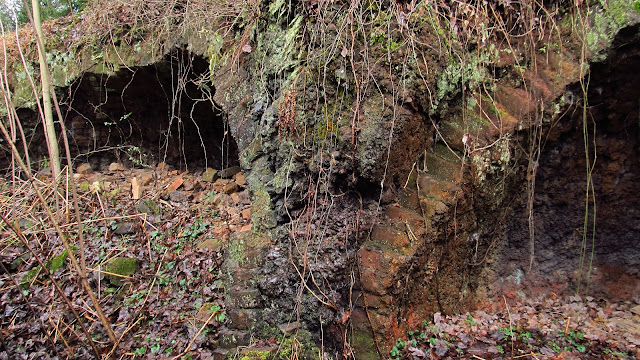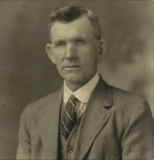Today we set out trying to get access to the Hecla No. 3 coke works along Boyer Road. Being unable to locate the property owner or figure out a way to penetrate the fortress, we were forced to move on. Fortunately when you're in Hecla you don't have to look very far. If anybody knows a way to get ahold of the property owner along Boyer Road with the big fence and large gate at the house, please let me know. We would really like to photograph those ovens.
Moving along we decided to first check out what was left of the Boyer Coke Works. We followed the right of way of the old Boyer Run Branch of the Pennsylvania Railroad through Hecla No. 1 until we got to what was left of the Boyer ovens. There wasn't much left but what does matter is there was at least something.
The Boyer Coke Works date back to 1905 and were constructed by the Mount Pleasant Coke Company. In the 1913 Water Services Industries Report, Boyer is listed as having 200 ovens. However, in the Connellsville Courier's "List Of Coke Ovens in the Connellsville District" of May 23, 1914 it is listed as having 120 ovens. Again, a different count can be found in the 1918 Pennsylvania Corporation Reporter where it lists the number of ovens at 95. The Courier coke oven reports are probably the most reliable and through the years 1906-1918 it says 120 ovens.
Regardless, this was a pretty long bank of ovens. It consisted of a very long bank and a shorter bank. Today all that remains are a few ovens from the smaller bank.
 | |
| Detail of the larger bank on the Hecla No. 1 mine map. |
 |
| Hecla No. 1 mine map showing the smaller bank as well as the Veteran Coke Works which we're going to be getting into in a little bit. |
The Boyer Coke Works stretched the whole way up to Udell Road. Where the current Cannonball Court is today, years ago the houses on this road were a bank of coke ovens. The road itself was a siding off the Boyer Run Branch that served the coke plant.
 |
| Hecla No. 1 mine map superimposed over a modern road map. |
Also, while looking at this map, I found across the road from Cannonball Ct. at Zufall Lane, was where the old Marion Coke Works were located. Another day.....
 |
| Hecla No. 1 mine map showing the Marion Coke Works. |
The important thing is what is left of Boyer today? Well, here are the photos of that:
 |
| Out of all those ovens this is all that remains. |
 |
| There still are some nice Crown bricks laying around. |
 |
| Not a lot left at all. |
Veteran Coke Works
For the past few years I have seen coke ovens in the yard of a private residence off of Armbrust Hecla Road. Today we decided to knock on the door and see if we could have a look. Thank you Michelle for letting us check out your coke ovens!!
The Veteran Coke Works were constructed over a decade earlier than Boyer. Veteran is first mentioned under this name in 1902, and is listed as being owned by the Veteran Coke Company of Greensburg. The Veteran Coke Works initially contained 60 ovens. This company also ran the Veteran Water Supply Company and built a reservoir near Armbrust on Baker Run. This reservoir served the coke works of the area as well as supplying municipal water for the borough of Youngwood. The reservoir encompassed 50 acres and touched no coal fields which could potentially damage the water quality. The coke plants as well as Youngwood were gravity fed from the reservoir.
Veteran Coke Company was formed in 1891 by J.A. (Josiah A.) Strickler of Wilkinsburg, J.U. Kuhns, and W.A. Wilson (both of Greensburg). Veteran Coke Works, previous to 1902 was known as Strickler Coke Works and may have continued to be referred to locally by that name.
By 1911 the Veteran Coke Works is listed as having 80 ovens. The total production for the Veteran Mine and Coke Works in 1912 was 61,020 tons of coal and 40,042 tons of coke. The Veteran Coke Company was an early incarnation of the Mount Pleasant Coke Company. All of this stuff gets connected somehow! For more information on the key players in this company, please see my earlier post I did on Carpentertown.
The Veteran Coke Works is listed as "being dismantled" in 1917 by the Coal Trade Journal of that year. The reason is due to the "last of the coal it owned has been used".
There are only a handful of ovens left today. The way some of the ovens have been incorporated into the property is about the coolest thing I have ever seen!
 |
| Two of the ovens being used for various things. |
 |
| And here is where it gets cool and completely ingenious. This is first coke oven I've ever seen converted into a kennel. |
 |
| In fact, it's probably the only coke kennel ever. |
 |
| An oven being used for firewood storage. |
 |
| Back behind the house are remains of the other ovens. This is directly across Boyer Run from the Boyer ovens we visited earlier. |
 |
| They're not in the best shape but at least Veteran Coke Works still exists in some form and are on property of someone who seems to respect them. |
 |
| They really have held up well after being cold for 98 years. |
 |
| Also behind the house are the remains of the ash or slate dump. |
 |
| Another look at the three well kept ovens. I love that kennel!! |
 |
| A couple of the ovens were lost when the driveway was put in. Still, the way the ovens are used in the landscape is brilliant. |
 |
| A couple more ovens behind the shed. |
 | |
| Ovens probably are buried under the bank. Still, it was very nice to let us on their property to look at their ovens. Thanks again!! |
Helen Coke Works
These ovens were the highlight of the day! There are only 8 ovens left at the Lohr Farm Coke Works but that's OK because there were only ever 8. These 8 ovens are by far the best preserved bank of ovens in Westmoreland County. These ovens have often been called Love Coke Works but a search of Love Coke Works kept turning up 32 ovens. On the Brinkerton-Mututal-United mine map these ovens are simply marked "Lohr". A search of "Lohr Coke" turns up 8 merchant ovens named "Helen" operated by a Samuel J. Lohr with a P.O. box in Youngwood. The February 17, 1917 "List of coke ovens in The Connellesville District" lists both Helen (8) and Love (32) in the same column.
 |
| Samuel J. Lohr 1862-1953 |
So if this isn't Love then where was it? Things get even more confusing when we find an S.I. Lohr being arrested on four violations of the state mining laws while working as the superintendent at the Love Mine of the Connellsville Mutual Coke Company in 1908.
 |
| Altoona Mirror October 10, 1908 |
Is this a misprint? Should it have read S.J. Lohr? I am going to call these ovens Helen. These ovens are certainly not chopped up. There are 8 ovens with two very prominent ends. If there were 32 ovens here at one time there almost certainly wouldn't be a perfect bank of 8. I would expect to see a bank of 32 or a block of 16 on each side.
Here's what is here today:
 |
| Beautiful ovens. |
 |
| Definitely the original end of the oven bank. |
 |
| These doors are extremely narrow. They also all still contain their original block as well as the iron frames. |
 |
| Notches in the iron for leveling the coke. |
 |
| Very unique colors. |
 |
| 7 out of 8 ain't bad. We have one collapsed oven. |
 |
| Perfectly intact other end of the bank. |
 |
| A look inside. |
 |
| Trunnel holes. |
 |
| The field behind the ovens. |
 |
| The other end of the bank. Mary Jane and Geno in the background. |
 |
| Geno taking a panorama. Most folks know him as Geno but we know him as Mr. Standard, Lord of Standard Shaft. Welcome aboard! |
 |
| Bent wrought iron fence with the ovens in the background. |
























Hi Mike! Great shots. I just thought I'd let you know that my brother lived on the property where he converted the oven into a kennel for his dogs. He sold the property and moved to Tennessee a few years ago.
ReplyDeleteWalt Komoroski
Hey Walt! That's great. That's a really nice piece of land there. Tell your brother I think he's a genius for building that kennel!
Delete